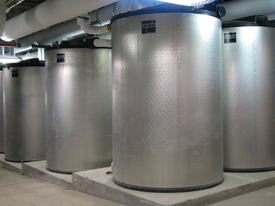Ice-Cooled Buildings Could Ease Strain On Power Grid
Texas A&M researchers are working to improve an “ice battery” system that freezes water at night to cool buildings during the day.
Ice has a proven track record when it comes to cooling drinks in the summer, so why not take it a step further? A big step, in fact, as thermal energy storage systems, often called “ice batteries,” are getting a boost from materials science research at Texas A&M University.
Dr. Patrick Shamberger, associate professor in the Department of Materials Science and Engineering, focuses his research on materials used to store and release thermal energy. In a paper published in The Journal of Physical Chemistry, he and co-authors explore how to improve the performance of these materials.
How It Works
Ice battery systems work by freezing water or other materials at night, when electricity is cheaper and demand is lower. The stored cold is then used to cool buildings during the day, reducing peak energy use and lowering costs. While the concept isn’t new, Shamberger’s research addresses a key challenge: how to make the materials inside these systems more efficient, stable and long-lasting.
“The ice battery technology has been around for a while,” Shamberger said. “But there are problems on the material side that I’m interested in: what’s the right material at the right temperature? Can we make it reversible? Can we make it last for 30 years?”
Although the systems save energy by relying less on the power grid during the day, they still draw power at night to freeze the water; larger systems freeze around 500,000 pounds of ice every night.

Thermal energy storage holds great potential for lowering electricity costs.
The Right Mix
Shamberger’s team is developing salt hydrates (salt that contains water molecules as part of its crystal structure) and other compounds that can store and release thermal energy at the most optimal temperatures for the environment.
By tailoring the temperature range of these materials, the team aims to improve energy efficiency and make the systems more compatible with both cooling and heating applications, especially in buildings that use heat pumps.
“We’re putting it at a specific temperature so it’s compatible with a particular HVAC system integration approach,” Shamberger said.
One of the biggest technical challenges is “phase segregation.” In many salt hydrate systems, the material separates into different solid and liquid phases with varying compositions and densities, which can degrade performance over time.
The study investigates how to prevent this degradation by better understanding the thermodynamics of these materials. The goal is to identify compositions that are more stable and can cycle reliably over many years.
A Cooler Future
The broader goal of Shamberger’s research is to support a more flexible and resilient energy grid. As renewable energy sources like solar and wind become more common, the grid faces increasing variability in both supply and demand. Technologies that can shift energy use away from peak hours are becoming essential.
“We don’t want to solve grid problems by building more power plants,” Shamberger said. “That’s a very costly solution and they’d have to charge higher rates overall.”
By storing cold when electricity is cheap and using it when demand is high, buildings can reduce their energy bills and help stabilize the grid. Shamberger said the ideal system would be one that integrates seamlessly into existing HVAC systems and operates automatically. Ice battery systems are already in use, including at the 30-story Eleven Madison building in New York City.
